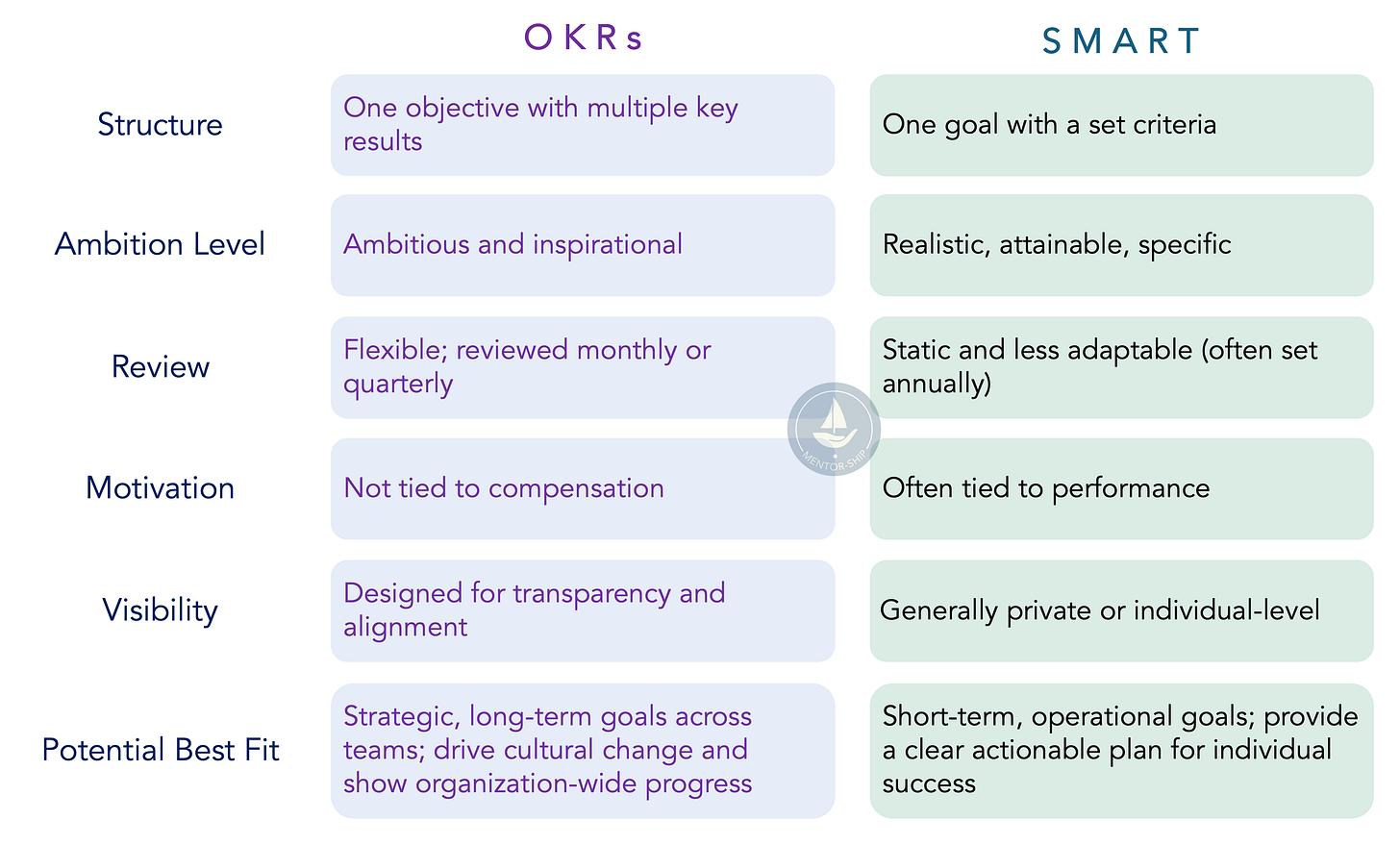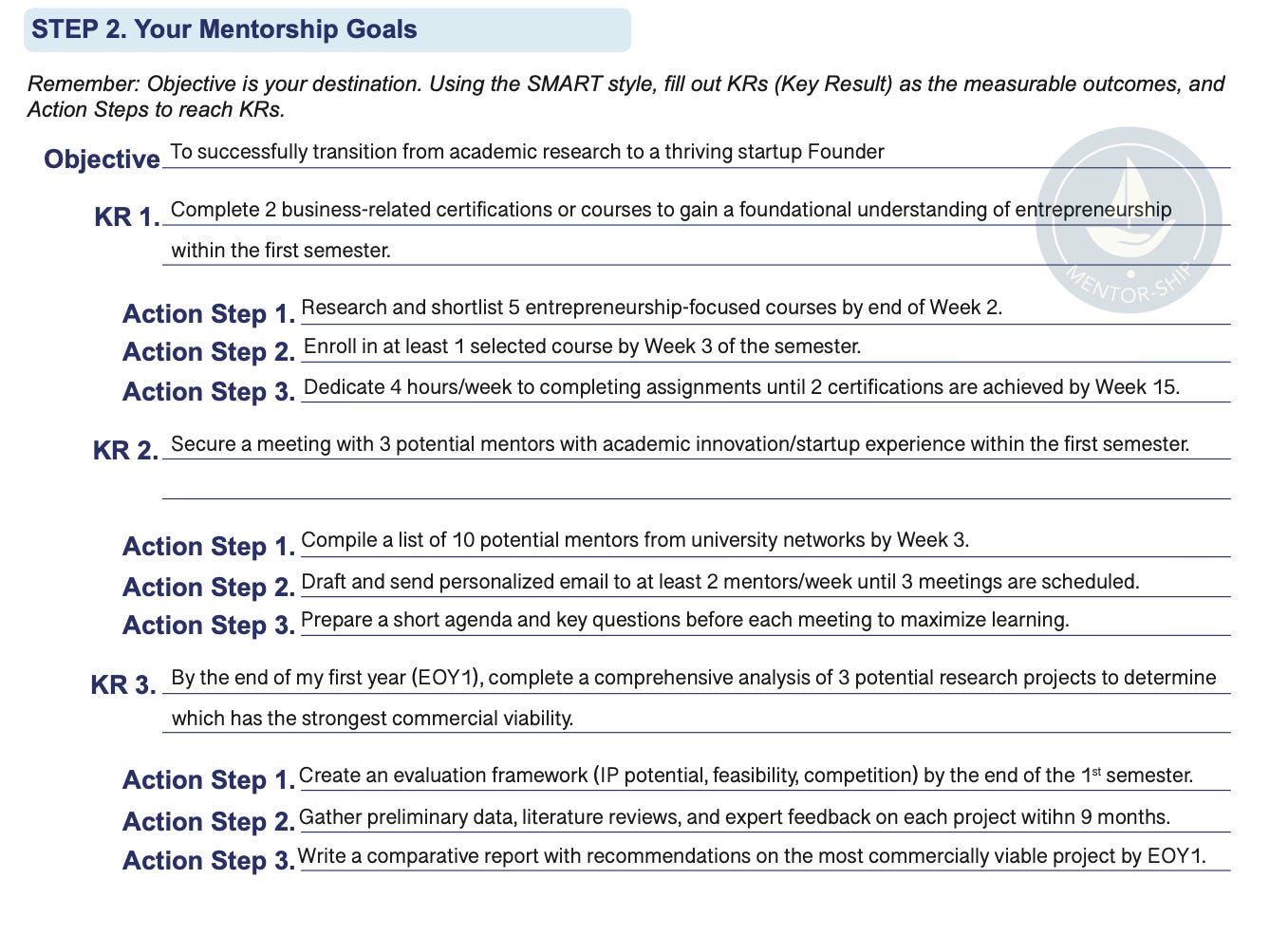Identifying Your Mentorship Coordinates
A Mentee’s Guide to Setting SMART and More Than OK Goals
“What is your goal?”
When someone asked me this question early in my career, it caught me completely off guard. I was more uncertain than certain about my path. I knew I wanted to work in science, but that is like saying you want to travel and seeing the world. But where are you going specifically?
Using a more specific analogy, imagine your goal is to scuba dive in the ocean. What a thrilling idea! However, a great mentor would ask for more details. Do you want to see the kelp forests of the California coast or the colorful corals of the Caribbean? Are you preparing for a trip next week, or is this a long-term dream you want to achieve in one or two years? Are you even ready to dive, or do you need to take a class first? These questions transform a vague desire into a concrete, achievable plan.
Just like with scuba diving, a successful mentorship voyage needs a clear destination. In the previous article of this series, you have started to map your inner world, exploring your core values and mission. You have also taken stock of the gear you already have. Now it is time to collect another vital item for your journey: the specific goal for your mentorship.
Let’s talk about how to set goals that will successfully guide you (and later on, your mentor) toward your destination.
The “Why” Before the “What”
In our last post, you started charting your inner world by defining your personal “why”. By connecting your core values and mission, your personal statement is the compass that point you in the right direction. Now, it is time to connect that big-picture purpose to a “Mentorship Why”.
Think of it this way: you know your ultimate destination is to dive with the magnificent marine iguanas in the Galapagos Islands, but now we need to figure out which leg of the journey you need a guide for. Do you need help with the initial certification, navigation in open water, or in having a travel plan?
Your “Mentorship Why” is the specific reason you are seeking a guide for this particular part of your adventure. It is the moment to reflect on where you are and where you want to go next, and how a mentor can help you navigate that path.
As you can imagine, Mentor-ship has a new worksheet for you (📥 download it here). Let’s ask those 3 key questions to get started:
Where am I? Example: “I’m in the first month of my PhD program in Nautical Engineering.”
Where do I want to be? Example: “After I defend my PhD, I want to open my dream startup, Blue Horizon Sails, using my knowledge of sails, navigation and eco-friendly materials.”
How will a mentor help me get there? Example: “My Mentor can help me with with (1) the technical skills and innovative aspects of my research, (2) networking with VCs and other business-related advisors, and (3) in launching the startup with me.”
💡Now, take a moment to write down your answers to these 3 questions. Be as honest and specific as you can. This is the essential first reading that will not only guide your goal-setting but also help you choose the right mentor for the journey ahead.
The “What”
“Knowing what you want is the first step toward getting it."
- Mae West, actress, singer and screenwriter.
With the “Mentorship Why” set up, it is time to define the specific destination, or the “what”. A vague idea like ”improve my leadership skills” is a great start but remember our diving analogy: it is like saying you want to dive in the Pacific Ocean. To have a truly successful mentorship, you need to be more specific like, “to dive in the Pacific and photograph the marine iguanas in the Galapagos Islands”.
But why is a clear destination so important? You can just drift along and see where the current takes you. However, psychologists have actually proven that goals are powerful tools as they affect your performance in 4 main ways:
Focus and Effort: Goals help you focus your attention and energy on the most important activities; while helping you avoid distractions.
Motivation: A challenging goal is more stimulating and leads to more effort than an easy one. When you aim higher, you will naturally put in more work.
Persistence: Goals give you a reason to keep going when the journey gets tough. They help you stay committed to your course, even when you face obstacles.
Strategy: goals indirectly fire up your creativity and problem-solving skills. When you know your destination, your mind naturally starts planning the best route to get there.
Thus, setting challenging and specific goals is like setting a perfectly tuned GPS. It keeps you on track and motivated, ensuring you never lose sight of your main objective. The challenge, of course, is that it is easy to get lost or influenced away from your goals, especially if you change courses too often or keep your goal too ample.
That is where goal-setting frameworks come into play. They are essential maps that help you define your destination and plot your course. The 2 most common frameworks are the acronyms OKR and SMART.
Let’s explore how each one can help you transform a broad idea into a precise goal and a concrete, actionable plan for your mentorship.
1. OKR – Objective and Key Results
I first came across the OKR term when I was doing a Project Management course. There, I learned what ORKs are and how to use them.
OKRs story began at Intel in the 70s, when Andy Groove introduced the concept. At the time, the company was going through a transition, and the goal was to help employees focus on measurable objectives aligned with the company’s new set of priorities and allow employees to know their contribution to this transition. OKRs facilitated communication, alignment and accountability during this process. John Doerr, one of Google’s early investors and a current Board of Directors member, was a young Intel engineer and learned Groove’s framework, which he later brought it to Google in 1999. OKR methodology became a cornerstone of Google’s growth and was eventually dispersed in businesses around the world.
So, what are OKRs?
O is for Objective: This is the ambitious, clear, and inspiring goal you want to achieve. Think of this as your destination.
KR is for Key results: These are 2-5 measurable outcomes that tell you whether you are on track to reach your objective. They are the mile markers of your journey.
Effective Key Results are results-oriented, measurable, and specific. They tell you how you are going to get to the end of your adventure. For example, at Google, hitting about 70% of your Key Results is considered a success because it means you set the bar high.
Now, here is how the OKR framework could look for our example of the PhD’s student journey:
Objective: To successfully transition from academic research to a thriving startup Founder.
KR1: Complete 2 business-related certifications or courses to gain a foundational understanding of entrepreneurship within the first semester.
KR2: Secure a meeting with 3 potential mentors who have experience in both academic innovation and spinning off start-ups within the first semester.
KR3: By the end of my first year, complete a comprehensive analysis of 3 potential research projects to determine which has the strongest commercial viability.
Notice how the Objective is aspirational, while the KRs are specific, measurable and tied to a timeline. Instead of a list of tasks, they are clear indicators of progress. Additionally, OKRs tend to be flexible in comparison to other styles. This is ideal for a mentoring relationship because they tend evolve over time and needs regular check-ins. You can (and should) review and adjust your OKRs with your mentor to ensure you are always on the right course.
If you want to dive deeper into the OKR framework or see other examples, here is a thorough, helpful video from Google Ventures:
💡 Now it is your turn! Use the worksheet to draft the OKRs for your mentorship journey. Think about your ultimate goal and then break it down into specific, measurable key results that will get you there.
We are almost there! Let’s wrap it up with SMART goals as a way to define action steps.
1. SMART- Specific, Measurable, Achievable, Relevant and Time-bound
SMART is a method for setting goals that has been around since a 1981 paper by George T Doran. Before SMART, business goals were often vague and hard to measure, leading to a lot of miscommunications. SMART gave people a simple, structured way to write goals that were clear, accountable and easy to evaluate. It is now a foundational tool for both business and individuals.
So, what does each letter stand for?
S is for Specific: A specific goal answers the “who, what, where, when, and why”. For example: instead of “I want to dive in the Pacific Ocean”, a specific goal would be, “ I (who) will scuba dive (what) in the Galapagos Islands (where) in 2 years (when) to photograph marine iguanas (why)”.
M is for Measurable: A measurable goal includes a way to track your progress and know when you have accomplished it. For example, “ I will complete my scuba certification, book my flights and tours, and save $5,000 for the trip” is definitely measurable, whereas “I will prepare for the trip” is difficult to pinpoint when it is complete because there is no measurable feature. You clearly know when you book a flight, or when you save a total of $5,000.
A is for Achievable: An achievable goal is realistic and attainable given your resources and constraints. It pushes you but does not set you up for failure. For example: “I will become a world-class marine biologist and get a grant to go on the trip within the next 5 months” might not be achievable if your profession is not in this field.
R is for Relevant: A relevant goal aligns with your objectives and values. It matters to you and fits within your plans. For example: “I will visit Chicago to see The Bean” is not relevant if you have a passion for marine wildlife and a desire to travel to unique, biodiverse ecosystems.
T is for Time-Bound: A time-bound goal has a clear deadline. This creates a sense of urgency and helps you stay on track. For example: “ I will go see the iguanas one day” has no deadline, but “ I will scuba dive in the Galapagos Islands in 2 years to photograph marine iguanas” has a very clear time point.
Some people prefer OKRs, while others prefer SMART goals. The truth is, they work great together. Think of it this way: your Objective is the big destination, your Key Results are the key milestones on the way, and your SMART goals are the precise action steps you will take to reach each milestone. KRs are often SMART themselves.
Most organizations find that SMART is excellent for guiding individual goals and projects, while OKR is a powerful tool for aligning an entire team or company with a larger strategy. In a mentorship, you can use both in synergy to improve your mentorship goals.
Here is an image comparing the 2 frameworks to help you:

Let’s go back to the PhD student and his OKRs. I filled out the worksheet with the Action Steps using the SMART strategy and added in the image below:

💡Now, it is your turn: Focus on 2 or 3 Action Steps using the SMART style for each OKRs in the worksheet.
After setting up your goals, you will have a clear vision of where you want your mentorship to take you. It may not be easy to write your goals at first, but this is a valuable skill that goes beyond this experience. Mastering clear, succinct, targeted goals by using these tools can be a game-changer for your personal and professional projects. Remember, these goals are a starting point, and you will refine them with your mentor, but that is a conversation for a later post in our adventure.
What a journey, and we have not even left the harbor! But the sun is setting once again, our gear is getting packed, and we now need to focus on another essential task: identifying the best captain for our adventure.
⛵️See you in the next post!
💬 How was your experience in setting up your goals? Share your feedback in the comments.
⛵️Keep sailing with us! Subscribe so you don’t miss our next post…
🌊Feeling lost at sea? We’ve got your back. Message me using the link below or through my website


